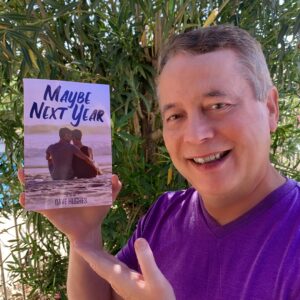If you’re curious about my first novel, Maybe Next Year, but you’re not sure what it’s about or whether you would enjoy it, perhaps my answers to these ten questions will fill in the blanks.
 What kind of book is Maybe Next Year? Is it a romance novel?
What kind of book is Maybe Next Year? Is it a romance novel?
It’s definitely not a romance novel, in the formulaic or categorical sense. There is romance in the novel, as our two main characters, Bryan and Chris, are high school best friends who gradually figure out they’re in love. But an expectation of every romance novel is that it has a “happily ever after” ending, and (spoiler alert!) Maybe Next Year does not.
So what is it? To me, it’s simply a compelling story that centers around gay characters and gay issues – especially issues the LGBT+ community was facing in 2007. There’s coming out, humor, drama, romance, conflict, and some revealed secrets – all the things you want in a good story.
If you’re wondering what the title means, there are several occasions when Bryan expresses his hope that maybe next year he and Chris can leave Kansas to go to college together, and they will be able to live their lives together more openly.
Why did you write this book?
After writing three books on retirement lifestyle and planning advice, I was ready to move on to something new. While writing those books and hundreds of articles for my website RetireFabulously.com, I discovered that I really enjoy writing, and I gradually got better at it. But the main reason I switched to gay fiction is that I had stories in my head I wanted to tell.
Why does the story take place in 2007?
There are two main reasons this story takes place in 2007. I wrote a lengthier answer in this blog post, but here’s the short answer:
First, subsequent novels will cover events in these characters’ lives as they complete high school, go through college, launch their careers, and build relationships in their 20s. By the time we get to the sixth (and, as of now, final) novel, they’ll be in their early 30s. So I had to start them as 17-year-olds in 2007 in order for them to age into their later roles.
Second, in each book, I want to capture some of the events of the time, especially as they pertain to the LGBT+ community. In the mid-2000s, homophobia was on a roll. Red states were passing constitutional amendments that banned same-sex marriage. Prominent anti-gay and ex-gay organizations were promoting gay conversion therapy and claiming that one could simply “pray the gay away.” The mid-2000s was the height of these movements. Sadly, Bryan experiences this first-hand.
Future books will reflect what is going on in society at the times those stories take place.
In the book, you describe Bryan’s visits to an ex-gay therapist. His parents attend a conference for parents and families of “people struggling with same-sex attraction” in which so-called “experts” make some pretty outlandish claims. It seems too bizarre to be real. Did you make that stuff up?
As the cliché goes, you can’t make this $#!T up! I wish I could say I did.

There were groups called Love in Action and Exodus International which claimed their members had “left the homosexual lifestyle” (as they put it) and reduced or eliminated their same-sex attraction.
There were conferences called “Love Won Out,” hosted by anti-gay organizations in cities around the United States, that targeted the parents of families of LGBT+ people and filled their heads with notions of how they could help their children or other loved ones “leave the homosexual lifestyle.” I found a lengthy (7-part) report written by someone who attended one of these conferences and documented what speakers said and what went on during the course of the event.
There were clinics and therapists who offered “gay conversion therapy” or “reparative therapy” to attempt to “cure” people of same-sex attraction. The spouse of one of the 2008 presidential candidates ran such a clinic and received government funding! I found an exposé written by someone who went to this clinic incognito and documented what happened and what he was told.
I did a lot of research into these organizations for this book. The names of the organizations and the practitioners, as well as the times and places of the events, were changed to protect the guilty (and to avoid being sued). What they said was paraphrased to avoid quoting them directly, but they are accurate – tragically.
I included them in the story because I think it’s important that we, as a society, do not lose sight of what went on in this country less than 20 years ago. Sadly, it looks like the pendulum is swinging back in this direction. Those who do not learn from history are doomed to repeat it. Gay conversion therapy has not been banned in many parts of the United States and it’s still being practiced, albeit much less frequently.
I did a lot of other research as well. For example, the Kansas state championship track meet really happened on May 25th and 26th at Wichita State University, as it does in the book. Kansas City’s pride festival really took place on June 2 at the World War I Museum and Park. I wanted to have Bryan and Chris watch the pride parade, but Kansas City didn’t have one in those days. Finally, there’s a bus trip in the book, and I researched the actual route the bus traveled and the times it would stop in each city or town. I used Google Street View to see parts of the route. I wanted the story to be as realistic as possible.
Are characters in the book based on real people?
No.
However, my husband Jeff claims he sees elements of my personality in both Bryan and Chris, such as their interest in big band jazz.
Is this book based on your experiences or on the experiences of people you know?
Only to the extent that I lived through those times.
Is there sex in the book, and is it explicit?
There is no explicit sex in the book. Bryan and Chris are 17-year-old boys with raging hormones and a deep love and desire for each other, so there are a couple of occasions when they explore and discover. But it happens “off the page,” meaning that by the time the chapter is over, you know what happened, but not in so many words. There are a few conversations about sex, as well.
You’ve said this book is the first in a series. Without giving away any spoilers, what will the next books be about? Does this story continue?
Bryan is the central character in the remaining books (most of the time), although he changes his name to Ryan for reasons you’ll learn near the end of Maybe Next Year. In subsequent novels, you’ll meet many new characters as Ryan goes through college, and even more as he settles into his professional career and experiences relationships.
That said, many of the characters in Maybe Next Year will reappear at some point or another in later books – including Chris.
Each novel will be written so that it can stand on its own. Each book will present enough background information to enable someone who hasn’t read the previous books to understand what’s going on. But the optimal experience will be to read the entire series in sequence.
Will Bryan and Chris end up together?
Not at the end of Maybe Next Year. As for subsequent books… You don’t think I’m going to let out that spoiler, do you? 🙂 In Instant Adult, we learn that Chris has a new boyfriend. In the fourth book, If I Seem Quiet…, (b)Ryan meets someone special. But… stranger things have happened!
What authors and/or books influenced your writing?
There are two in particular.
One is Armistead Maupin, who wrote the Tales of the City series – nine books in all. These books follow a set of characters in San Francisco as they move through various stages of their lives. Situations change, other people come and go, and all sorts of wild and crazy things happen to these people. Each book is a reflection of the times in which the stories take place. I have modeled the format of my books after this type of long-range, life-stage storytelling. During the pandemic, I re-read the entire series to study how he wrote these books and to simply enjoy them again. I had forgotten a lot over the years.
The other is Bill Konigsberg. Bill has written seven Young Adult novels, many of which have won awards. Through his books, he inspired me to write about teenagers. Our writing styles and the nature of our stories are different, but I have enjoyed his books immensely and learned a lot from them. He’s a master at this craft.
Maybe Next Year could qualify as a Young Adult novel, but the characters grow older in subsequent novels and some situations are more “adult” than might be appropriate for a YA novel.
My next three novels, Instant Adult; Open Books, Closed Sets; and If I Seem Quiet… are now available. It’s not necessary to read Maybe Next Year before you read the subsequent novels, but doing so will enhance your experience. The fifth novel in the “Gay Tales for the New Millennium” series, Karma Train from Kansas, will be released in April, 2024.
Subscribers to my newsletter will have the opportunity to purchase subsequent books at discounted prices as they are released. You can subscribe to my newsletter in the box below.

Read Cruise Virgins for Free!
Cruise Virgins is a short story about two young men experiencing their first gay cruise. You'll meet some of the characters in the "Gay Tales for the New Millennium" books. It's a perfect introduction to that series.
I'll send occasional emails that will keep you informed about my upcoming books and offer them to you at a discount. I'll share background information about the stories and the writing process. Occasionally, I may solicit your input which will help make the books even better!
If at any time you'd rather opt out, you can unsubscribe with one click. And of course, I would never share your info with anyone else.
© 2022 Dave Hughes. All rights reserved.
Photo credit for Dave holding book: Jeff McKeehan.
